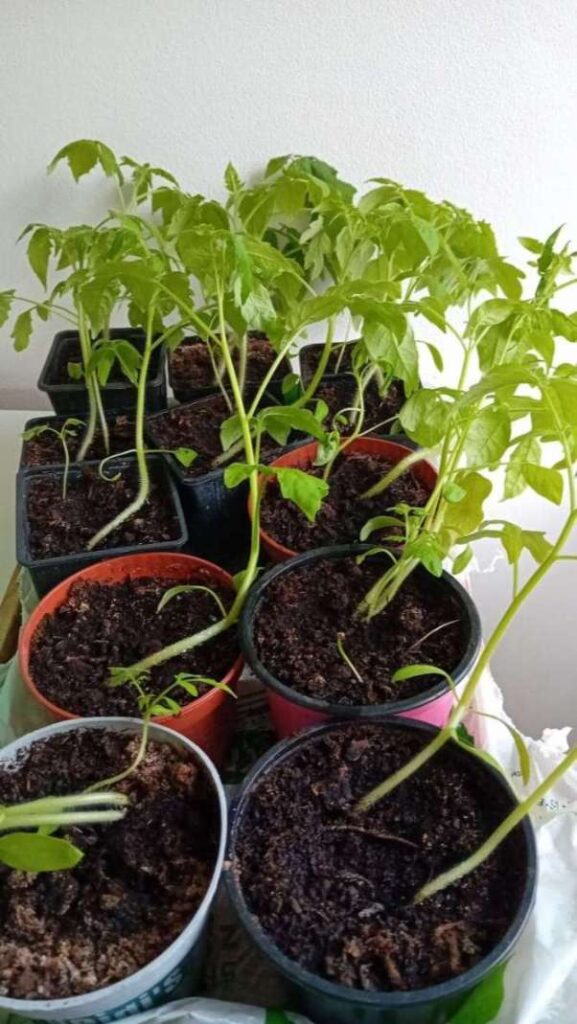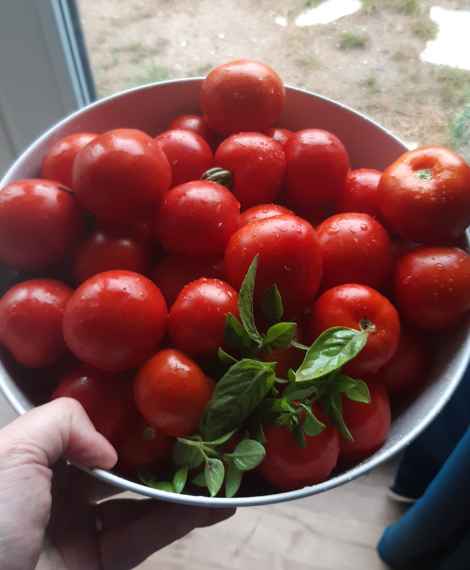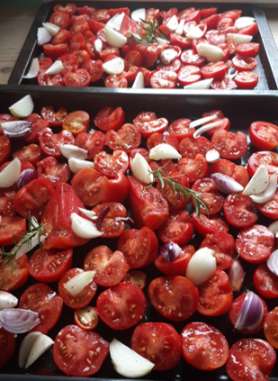In this blog post, you can learn and read about tomatoes and how to grow them.
In this post, you will be able to learn and read about how to plant tomatoes from seeds. Whether it is from seed or seedling – let’s plant tomatoes!
Going to the forest or garden was boring when I was a small girl. I was attracted to big cities, lights, noises, and things seen on TV. Neons – oh wow.
My parents passionately took me to our garden and tried to teach me how to care for plants. Strawberries, grapes, tomatoes, and many more… and I wanted the big world.
How have times changed?
In my late 20s, I was working in the corporate world already for a few years. I tasted it all, the pace, the deadlines, the Zoom meetings that could be emails. I was looking for the slowdown, calmness, nature, and general peace.
What do we want? What do we discover?
Life is fast and quick. Things pass in a blink and we, meanwhile, work (often a lot!). Where to find that slowdown?
Going back to roots or learning it from scratch can bring joy, but it is easier said than done, hmm?
We have too much on, we want too much, all at once. This long-winded intro brings me to the subject of what we are here for – tomatoes 🙂
After a few years of roller coaster work, I started turning into nature. You can read in my beginner guide to growing flowers from seeds my gardening journey started on an 8th-floor balcony. That’s where I grew my first sunflowers, peppers, and tomatoes. Planting tomatoes from seeds had a special place in my heart. It reminded me of the homemade tomato salads from my childhood. Eating them together as a family with my parents and brother. These were good times that I wanted to recreate in my adult life.
In this blog post, I will share with you how to plant tomatoes from seeds or seedlings (if you prefer). You will also find here information about what plants complement tomatoes’ flavour and well-being. As well as what plants to avoid next to your tomatoes. So yes it is a complete beginner’s guide to planting tomatoes from seeds and caring for them 🙂
Planting from seeds.


Also observe the level of satisfaction that it brings you 🙂
There it is, you have learned how to grow tomatoes from seeds. But, it does not have to be tomatoes – we start with them simply because they have a special place in my heart <3. You will be able to find here many other tips on growing things, with some down-to-earth instructions. Throughout my ‘gardening career’ I have read many books that simply scared me with its complexity. Here you will find simple tips to get the best results and crop.
I want to make it clear though – I am somebody who learned by the ‘try and fail’ method. Some things simply stay in the sphere of an experiment for me. I may still share them in other blog posts and you can expect honesty if something does not work out.
Moving forward with our planting, in the photo you can see the progress of our seedlings.
Whilst growing tomatoes at home – when your seeds sprout
Growing Tomatoes at home – care tips


To start with the plants will need water, sun, and some attention – singing and talking to them might help too.
As they grow, they may start needing support. Especially if they start leaning towards a side. It is perfectly normal, and you just need to help them straighten up. Tomatoes are not plants to keep straight on their own, therefore have some small sticks ready and help them out. In the photos on the left, you can see my tomatoes when they started to lean towards one side. Normally it happens when they lean towards the window. The best practice is to give them a stick. Every couple of days, move the plant on the windowsill. This helps the plant grow as straight as possible.
Ready to go outside tomatoes!
Looking after our seedlings when they first move out – how to plant tomatoes from seeds
When the frost risk at night is gone and our plants are about 10-15cm tall we can start taking them out.
I am located in central Europe, so it is usually around the 15th of May. Some people like to ‘condition’ plants, by first taking them outside and keeping them out overnight. If you have time for it – great, do it, it will help plants adjust to living outside. Even taking them out for a few hours during the day may be helpful. Normally they are not used to direct sunlight so they may look like their foliage is weathered. It is normal, so don’t overthink it, just accept it and move on – plants will be fine eventually.
Where to plant them? Directly into the soil in your garden, into a raised bed, or if you have a balcony available let them grow there. All is a good idea. Important is that they get sun. Plenty of it. They like full sun – ideally 6-8 hours per day. This way you can count on a sweet fruit crop. Yes, botanically speaking tomato is a fruit 🙂
Preparing soil before planting your seedlings:
- Dig the soil first – 20-30 cm in and remove all weeds and small roots.
- Dig a hole for approx. 20cm and put on the bottom of it some nettles (yes – natural fertilizer!)
- Cover nettles with a layer of soil with humus – 5cm
- Then put your tomato plant in and cover the hole fully with soil.
- Water it generously and put it in a stick for support.


In A Nutshell: How to plant tomatoes from seeds when they are ready to go outside as a seedling
- Research your Hardiness zone to know when you can plant outside.
- For a week or so before planting keep bringing tomatoes outside to let them adjust to UV light and wind.
- If you put nettles on the bottom of the planting hole cover it well with soil. It is a natural fertilizer. However, you don’t want to put the plant’s roots directly on it.
- When you tie your plant to the stick do it in the shape of number 8 (see photo below). You want to give the plant space to grow its stalk too.
- Every week or so remove bottom leaves so none are touching the ground. This is an important part of caring for plants, otherwise, it may increase the risk of various issues.
- Don’t water your plants during the day, especially in direct sun. Try to do it in the morning before the sun is strong or in the evening. Also, do not water it on the leaves, aim at the soil around the stem. Frequency of watering can be 2-3 times a week. It is enough unless you have 30C daily then you will need to water more often.
- Clear the weeds regularly, or as often or as seldom as you can. Try not to leave it without clearing weeds for longer than two to three weeks.

When they are ready to be eaten and enjoyed
When your tomatoes start getting the right colour – think of things to do with them, some of my favorite things:
- Tomato, onion and olive oil salad
- Tomato soup
- Salsa sauce – (super tasty beating up all shop-bought salsas)
- Passata
- Bruschetta
- And wherever else your imagination with tomato takes you.



Good neighbors to be around tomatoes and the ones to avoid – how to plant tomatoes from seeds
Last part of this blog post is about plants that complement and promote growth of tomatoes. There are some neighbours that can be beneficial and improve growth and flavour. Below some honourable mentions:
Plants complementing tomatoes
- Basil. It not only goes well with tomatoes on a plate, but it can also be very beneficial growing right next to them. Basil repels pests like flies, mosquitos, and aphids and at the same time, it enhances the flavour of tomatoes.
- Marigolds and Nasturtiums. They deter nematodes and repel other pests (aphids and whiteflies). They have a strong scent, and it can mask the smell of tomato plants, making them less attractive to pests.
- Calendula. Calendula flowers attract beneficial insects like hoverflies and ladybugs which feed on aphids and other pests. See my guide where I describe how to plant flowers from seeds. Calendula is one of 5 flowers described there.
- Garlic and onion. They repel pests (aphids, spider mites, and tomato hornworms). Planting them nearby will help protect your tomatoes.
- Lettuce. Lettuce can provide shade and help retain soil moisture. Interplanting them can maximise space and promote a diverse ecosystem.
These companion plants can help support growth whilst providing additional benefits to your garden ecosystem. Have fun with what you put near your tomatoes, experiment with it. Ultimately if you plant nothing, weeds will grow for sure. However, if you plant some of the above plants it may add extra ingredients to your salad and a beautiful colour to your garden.
Plants to avoid next to our tomatoes
Lastly, some plants don’t like to be next to each other. I am sure I will write a full post about it one day. For now a short mention here with tomatoes in mind. You should not plant them close to:
- Potatoes – simply because they are prone to similar diseases.
- Walnut trees – produce juglone, a chemical compound that can inhibit the growth of many plants, including tomatoes.
- Corn – they have similar nutrient requirements and may compete for resources.
- Brassicas (e.g., cabbage, broccoli, cauliflower) – they release chemicals that can inhibit the growth of your tomatoes
The above short guide gives you comprehensive, informative, and above all simple instructions on how to plant tomatoes from seeds. It’s a fruit full of vitamins that will promote your health, it also has great taste and can be used in many dishes.
If you got to that point of the article – stop scrolling for now, go out, disconnect from the virtual world. Plant some tomatoes. If that’s knowledge for the future, still put away your phone or laptop and spend some time in nature. It will do you good.
With a love for nature,
Anna B-M



